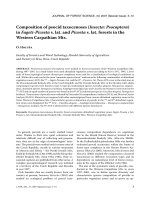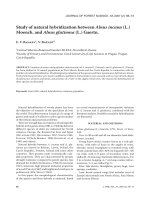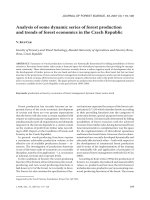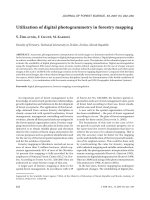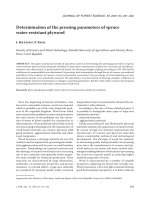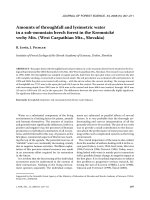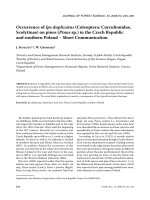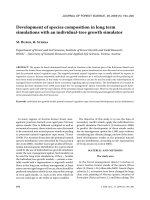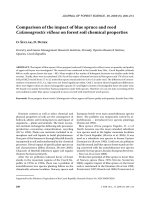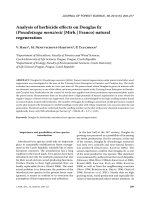Báo cáo lâm nghiệp: "Study of natural hybridization between Alnus incana (L.) Moench. and Alnus glutinosa (L.) Gaertn" pptx
Bạn đang xem bản rút gọn của tài liệu. Xem và tải ngay bản đầy đủ của tài liệu tại đây (862 KB, 8 trang )
66 J. FOR. SCI., 53, 2007 (2): 66–73
JOURNAL OF FOREST SCIENCE, 53, 2007 (2): 66–73
Natural hybridization of woody plants has been
the objective of research of the specialists all over
the world. is phenomenon is typical of a range of
genera and study of it allows to solve a great number
of theoretical and practical problems.
ere are enough data on existence of interspecific
hybrids in the genus Alnus Mill. s.l. Hybrids between
different species of alder are indicated for North
America, Europe, the Russian Far East and Japan
(H 1957; M 1957; S 1961;
F 1979a,b; B 1980; B et al.
1989, and others).
Natural hybrids between A. incana and A. glu-
tinosa are known in Belarus, Latvia, Poland, the
Czech Republic, Sweden, Ireland and some other
countries. ey possess many economically valu-
able properties. ey are characterized by greater
drought resistance compared to parent species, less
demand for fertility (K 1956; K
1957), heterosis, high physical-technical properties
of wood (P 1962) and heightened resistance to
pythium rot (F, Š 1963).
In this paper, the morphological characteristics
of the species and their hybrids is analyzed, based
on actual measurements of intraspecific variation
in A. incana and A. glutinosa, combined with the
literature analysis. Possible reasons for hybridization
are discussed.
MATERIAL AND METHODS
Alnus glutinosa (L.) Gaertn. 1791, Fruct. et Sem.,
2:54
Tree, to 30 m tall and 40 cm diameter; bark dark-
brown, cracked.
Young leaves sticky; mature leaves as a rule gla-
brous, with tufts of hairs in the angles of veins,
obovate, round, emarginate or rounded at tip, with
broad-cuneate base, (4)5–8(9) cm long and (3)5–7(8)
cm wide, with 6–8 pairs of secondary veins, leaf
stalks 20–35 mm long. Staminate inflorescences, 3 to
5 in a cluster, hanging, 4–7 cm long; mature infruc-
tescences, 3–5, on stalks (Fig. 1).
Sites: lake shores, floodplains, grassy bogs, near
springs, roadsides.
Area: broad natural range that includes most of
Europe and extends into North Africa, Asia Minor,
and western Siberia
Study of natural hybridization between Alnus incana (L.)
Moench. and Alnus glutinosa (L.) Gaertn.
Е. V. B
1
, V. B
2
1
Central Siberian Botanical Garden SB RAS, Novosibirsk, Russia
2
Faculty of Forestry and Environment, Czech University of Life Sciences in Prague, Prague,
Czech Republic
ABSTRACT: Variation of metric and qualitative characteristics of A. incana (L.) Moench. and A. glutinosa (L.) Gaertn.
has been studied in 10 natural populations in West Siberia, Russia and the Czech Republic in connection with the
problem of natural hybridization. Morphological peculiarities of the species and their spontaneous hybrids are shown.
Twelve leaf characteristics were used, in addition, qualitative characteristics were assessed, such as: type of bark, degree
of pubescence of leaves and stems, and presence of a “tuft” in the angles of leaf veins. e reasons for hybridization of
these species are discussed.
Keywords: Alnus Mill.; natural hybridization; variation; population
J. FOR. SCI., 53, 2007 (2): 66–73 67
Chromosome number: 2n = 28 (Chromosome
numbers … 1969).
Alnus incana (L.) Moench. 1794, Meth.: 124
Coarse shrub or tree, to 20 m tall and 50 cm diam-
eter, bark smooth, gray or brown. Mature leaves egg-
shaped to elliptic, commonly with sharp-pointed tip
and broad-cuneate, rounded or slightly heart-shaped
base, densely haired to glabrescent below, (4)5–9(11)
cm long and (3)4–7(8.5) cm wide, with (9)11–13(15)
pairs of secondary veins; stalks 10–30 cm long; ma-
ture infructescences commonly sessile, 3–5 (10 and
more) in a lateral cluster (Fig. 2).
Sites: streambanks, temporary watercourses along
the roads, moist sites at the foot of upland, grassy
bogs, felled and burnt areas, abandoned meadows
and plough-lands.
Area: North, Middle and Southeast Europe, boun-
dary of West Asia: West Siberia, Caucasus, Lebanon.
Chromosome number: 2n = 28 (Chromosome
numbers … 1969).
Material for the study has been collected in 1996,
1998, and 2003 from six populations of A. incana
and four populations of A. glutinosa on the eastern
border of the species areas in West Siberia, Russia,
and in the Czech Republic (Table 1). Leaves were
collected from 15–20 individuals at each population.
5 shoots were taken at lower, middle, and the top part
of crown of each tree. 10 leaves were measured from
each part. Hybrids were disclosed in populations 4,
6, and 10. e methods of material collection and
the measurement procedure followed the work by
B and S (2000).
A leaf is one of the main organs involved in plant
functioning. In this regard its characteristics are
subjected to a considerable pressure of selection. At
the same time, leaf habit plays a crucial role in the
systematic of the genus Alnus Mill. s.l. is is re-
flected in rather high resistance of its characteristics
to modifying influence of the environment.
In addition, qualitative characteristics were as-
sessed, such as: type of bark, degree of pubescence
of leaves and stems, and presence of a “tuft” in the
angles of leaf veins. e degree of pubescence was
determined on a 5-point scale: glabrous (full absence
of hairs) – 0; singly haired (separately standing
hairs) – 1; sparsely haired (hairs are scattered on the
surface) – 2; densely haired (hairs cover 50% of the
surface) – 3; and eriophyllous (hairs cover 100% of
the surface) – 4.
Fig. 1. Alnus glutinosa: 1 – staminate inflorescences, 2 – pis-
tillate inflorescences, 2* – mature infructescences, 3 – bark,
4 – cover scale, 5 – fruit, 6 – winter bud. Locality Konyashin-
skaya – Russia, Tyumen Oblast, motorway Tyumen-Turinskaya
Sloboda, 5 km from v. Konyashina, terrace of the Tura River
Fig. 2. Alnus incana: 1 – staminate inflorescences, 2 – pistillate
inflorescences, 2* – mature infructescences, 3 – bark, 4 – cover
scale, 5 – fruit, 6 – winter bud. Locality Konyashinskaya – Rus-
sia, Tyumen Oblast, motorway Tyumen-Turinskaya Sloboda,
5 km from v. Konyashina, terrace of the Tura River
68 J. FOR. SCI., 53, 2007 (2): 66–73
Endogenous (variation of metamers within an in-
dividual) and individual (intrapopulation) forms of
variation were analyzed.
e method of major components applied in the
study of plan natural hybridization (A 1982;
W 1992, and others) was used for the identi-
fication of spontaneous hybrids and the analysis of
their variation.
RESULTS AND DISCUSSION
Endogenous variation
Qualitative characteristics (pubescence of leaves
and young stems) of the crown of the species studied
are distinguished by a rather high stability. Absence
of variation of the degree of leaf pubescence within
a young stem is typical for the majority of A. incana
specimens. Insignificant increase in pubescence of
the lower leaf side towards the young stem apex was
found in only few individuals (about 5%). However,
maximum differences amount to 2 points. For in-
stance, lower leaves are glabrous and upper ones are
Table 1. Sites of material collection
No. Species Population Locality
1
Alnus incana (L.)
Kyshtyrlinskaya
Tyumen Oblast, Yalutorovsky Region, vicinities
of v. Vinzili, verge of the road
2 Dolmatovskaya
Kurgan Oblast, intersection of the motorway
Shadrinsk-Dolmatovo with the Suvarysh River
3 Golovinskaya
Tyumen Oblast, Yalutorovsky Region, vicinities
of v. Golovino, terrace of the Pyshma River
4 Konyashinskaya
Tyumen Oblast, motorway Tyumen-Turinskaya Sloboda,
5 km from v. Konyashina, terrace of the Tura River
5 Bobrovskaya
Sverdlovsk Oblast, Baikalovsky Region, vicinities
of v. Pelevino, floodplain of the Bobrovka River
6 Lipnovská
the Czech Republic, Šumava Mts. (Bohemian Forest), vicinities
of Černá v Pošumaví, Lake Lipno
7
Alnus glutinosa (L.)
Kyshtyrlinskaya
Tyumen Oblast, Yalutorovsky Region, vicinities
of v. Vinzili, floodplain of the Kyshtyrlinka River
8 Raskatikhinskaya
Kurgan Oblast, Glyadyansky Region, vicinities
of v. Raskatikha, the Chernaya River
9 Golovinskaya
Tyumen Oblast, Yalutorovsky Region, vicinities
of v. Golovino, terrace of the Pyshma River
10 Lipnovská
the Czech Republic, Šumava Mts., vicinities of Černá
v Pošumaví, Lake Lipno
Fig. 3. Leaf characteristic
Twelve leaf characteristics were used:
1. length of a leaf blade (A, mm)
2. width of a leaf blade (B, mm)
3. length of a leafstalk (I, mm)
4. number of pairs of lateral veins (N)
5. distance from the base of a leaf blade to its widest
part (D, mm)
6. leaf width at the tip (E, mm)
7. upper angle of a leaf (W, degree)
8. lower angle of a leaf (H, degree)
9. leaf coefficient (B/A)
10. D/A
11. I/A
12. E/B.
J. FOR. SCI., 53, 2007 (2): 66–73 69
sparsely haired. e leaves in all specimens studied
of A. glutinosa had hairs in the angles of the veins
– “tufts”. is characteristic is stable at the endo-
genous level.
Metric characteristics change uniformly. For
instance, the finest leaves are at the base of young
stems. They increase gradually in size along the
length of the stem towards the apex. However, the
upper leaves are smaller. ere is a high correlation
between the absolute characteristics at the endo-
genous level; it is especially common to A, B and D.
Length of a leafstalk and a number of pairs of lateral
veins are related to a lesser extent to the size of a
leaf blade. e correlation between absolute char-
acteristics of an alder leaf testifies to great genetic
determination of the leaf shape, lesser dependence
on internal conditions of organ formation (e.g., stem
size) and greater resistance to modifying influence of
the environment (e.g., intensity of natural illumina-
tion). In addition, relative characteristics (B/A, D/A)
of the crown vary to a lesser extent than absolute A, B
and D. Variability of characteristic I/A is comparable
to that of the length of a leaf blade, but it is always
lower than variability of the length of a leafstalk. e
least variation at the endogenous level is typical of
the leaf coefficient, number of pairs of lateral veins
and D/A.
Intrapopulation variation
Sufficiently high stability of pubescence is typi-
cal for A. glutinosa. Densely haired or eryophillous
forms were found in none of the populations. In most
of specimens, leaves and young stems were glabrous
or singly haired. Only in Kyshtyrlinskaya population
about 20% of specimens were sparsely haired on the
upper side of leaves. All plants had “tufts” in the
angles of the veins.
Eryophillous forms were not found in A. incana
either. Densely haired specimens occur very seldom.
Table 2. Variation of morphological characteristics of A. incana, A. glutinosa and their hybrids
Characteristic
A. incana A. glutinosa Hybrids
lim
x
lim
x
lim
x
A
42–105
70
50–90
68
61–80
70
B
32–87
53
44–85
61
50–67
58
B/A
0.56–0.95
0.77
0.75–1.09
0.91
0.82–0.85
0.84
I
12–30
19
18–35
26
16–24
14
N
9–15
12
6–8
6.5
9–10
9.7
D
21–62
35
30–56
40
36–40
37
E
10–40
19
30–60
42
32–35
33
I/A
0.18–0.38
0.28
0.27–0.49
0.37
0.24–0.3
0.28
E/B
0.19–0.56
0.35
0.55–0.81
0.67
0.51–0.7
0.59
D/A
0.38–0.61
0.50
0.5–0.7
0.61
0.5–0.59
0.54
W
30–80
49
93–160
125
70–90
80
H
45–105
69
45–85
61
50–85
67
Symbols of the characteristics are in the text, lim – extreme value of a characteristic, x – mean value of a characteristic
70 J. FOR. SCI., 53, 2007 (2): 66–73
Plants with sparsely haired leaves (up to 90%) and
young stems (57–100%) prevail in most of popula-
tions. Forms with glabrous and eryophillous stems
are sometimes found in the populations. ere is
often no correlation between pubescence of differ-
ent surfaces of leaves and stems, which apparently
testifies to independence of inheritance of the char-
acteristic. ere is not any association of pubescence
of vegetative organs with peculiarities of the habitats
of A. incana.
Most of quantitative characteristics used easily
differentiate the species studied. For instance, mean
population values of the leaf coefficient differ sig-
nificantly. In A. incana it is 0.75–0.79 and in A. glu-
tinosa – 0.91–0.92; I/A – 0.27–0.28 and 0.37–0.39,
respectively; E/B – 0.34–0.36 and 0.66–0.68; D/A
– 0.49–0.52 and 0.58–0.62. However, these charac-
teristics overlap in separate specimens of the spe-
cies. Transgression may reach 40% and more. Such
characteristics as number of vein pairs and upper
leaf angle are species specific (A. incana – 9–15 and
30–80 degrees, A. glutinosa – 6–8 and 90–160 de-
grees, respectively) (Table 2).
A factor analysis of characteristics performed in
populations with participation of hybrids showed
that almost 80% of variation fell on the first and
second components (Table 3). ere is the closest
relationship between the first principal component
and N, W, E and E/D characteristics and a rather
high correlation of the former with D/A, B/A, I and
I/A characteristics. e species studied are separated
in the plane of the first two principal components
(Fig. 4). By a complex of characteristics hybrids hold
an intermediate position or are closer to A. incana.
It is rather complicated to describe hybrids as
there is a diverse combination of characteristics. For
instance, the specimens with the leaf blades typical
of A. incana may have “tufts” in the angles of veins
and cracked bark characteristic of A. glutinosa.
Moreover, the leaves closer by their shape and some
other features to both species occur on the same
young stem (Fig. 5). A similar situation was also
noted by different researchers (Y et al.
1963). One of the distinctive and sufficiently stable
properties of the hybrids is a number of pairs of leaf
veins – 9–10.
According to data of K (1969), the bark
of hybrids raised as a result of artificial crossing is
greenish- or brownish-gray, remains smooth with
age. Separate dark-gray longitudinal cracks up to 1 m
long and 3–4 cm wide may appear on the stem at the
age of approximately 20. Leaves are somewhat hairy,
Table 3. Correlations between characteristics and principal components
Characteristic 1
st
component 2
nd
component Characteristic 1
st
component 2
nd
component
A 0.31 –0.94 E –0.93 –0.15
B –0.40 –0.80 I/A –0.77 0.15
B/A –0.80 0.13 E/B –0.92 0.15
I –0.63 –0.46 D/A –0.86 0.23
N 0.94 –0.16 W –0.94 0.02
D –0.49 –0.71 H 0.47 –0.18
Share of component influence 57% 21%
Fig. 4. Distribution of the alder specimens
from “hybrid” populations in the plane of
the first two principal components (factors):
1 – A. glutinosa, 2 – A. incana, 3 – hybrids
0
0.2
0.4
0.6
0.8
1
0 0.1 0.2 0.3 0.4 0.5 0.6 0.7 0.8 0.9
Factor 1
Factor 2
1 2 3
1
2
3
J. FOR. SCI., 53, 2007 (2): 66–73 71
not shining, yellowish-coloured below. Usually there
are 9 pairs of lateral veins. As a rule, hybrids interme-
diate by size, shape, pubescence of leaves, habit and
bark color are in mid-position by time of the onset of
certain phenophases, e.g., blooming and leafing.
P (1994) indicated their great affinity with
A. incana when studying morphological peculiarities
of natural hybrids between A. incana and A. gluti-
nosa in Ireland. Variation of separate characteristics
such as length of a leaf blade and angle between the
central and lateral veins exceeds variation in both
parents. A number of vein pairs in hybrids is distin-
guished by high stability and on the average amounts
to 10.5. A great quantity of glands on the abaxial
leaf side is typical for the hybrids compared to both
species. In A. incana, on the average, 1–3.2 glands
occur on 1 mm
2
of the surface chosen by chance; in
A. glutinosa – about 0.4; and in hybrids – 3–9 glands.
Catkins of hybrids are more slender and pointed
(F, Š 1963).
However, hybrid forms do not often occur, espe-
cially in the area of continuous distribution of the
species. e main reason for it is considered to be the
absence of coincidence of flowering stages (Y-
et al. 1963; P 1980). In Belarus, for
instance, A. incana begins to blossom, on the aver-
age, 6 days earlier than A. glutinosa, which provides
complete pollination of the plants by proper pollen,
although flowering periods of the species overlap.
As V.P. Parfenov notes, probability of these species
crossing increases in anomalous years, e.g., in those
with cold prolonged spring. Moreover, an increase
in frequency of hybridization is noticeable on the
borders of the areas and in local “island” populations.
e author attributes this peculiarity to presence
of specific conditions for flowering and pollination
phases, as well as to the fact that polymorphic spe-
cies in adapting are capable to change their structure
and pattern of many biological processes.
An analysis of phenological data on A. incana and
A. glutinosa when introducing them beyond their
natural ranges allows to conclude that plants keep
species specificity for a long time, at least in the
first generation. So at the Altai experimental station
(Gorno-Altaisk, Russia) A. incana began to blossom
on the average 7 days earlier than A. glutinosa, and
flowering periods of the species did not coincide for
1–2 days (L 1974). By our data, in Central
Siberian Botanical Garden, SB RAS (Novosibirsk,
Russia) the end of flowering of A. incana falls as
usual on the beginning of flowering of A. glutinosa.
Separate samples of A. incana due to their biologi-
cal peculiarities or under influence of microclimatic
conditions were in blossom at one time with A. glu-
tinosa. Usually A. incana begins to blossom a week
earlier than A. glutinosa.
Fig. 5. A specimen of hybrid between A. incana
and A. glutinosa. Locality Lipnovská, the Czech
Republic, Šumava Mts. (Bohemian Forest), vicini-
ties of Černá v Pošumaví, Lake Lipno
72 J. FOR. SCI., 53, 2007 (2): 66–73
Apparently besides phenological peculiarities
preventing hybridization between A. incana and
A. glutinosa, there are some other mechanisms of
their isolation, as these species grow together in
a large area in different climatic conditions. The
tests on artificial hybridization provide support
for it. All researchers engaged in this problem note
a difficulty of hybridization between A. incana
and A. glutinosa. For instance, K (1968)
indicated that successful hybridization was only
observed in that case when A. incana was used as
a maternal plant. Hybridization went unrewarded
when A. glutinosa was a maternal plant. Seeds ob-
tained in the process of hybridization gave viable
seedlings, but the quality of seeds was low. Germi-
nation amounted to only 12–13%. V (1963)
obtained hybrids between these species using
5-year individuals as maternal trees and 25 to
60-year ones as paternal plants. By his data, when
crossing young plastic hybrids, the seeds obtained
were of high germinating ability and gave late het-
erotic generation.
Our study has shown that hybrids between
A. incana and A. glutinosa occur very seldom in both
European part and West Siberia – on the eastern
border of the species areas. Based on the literature,
we can say about somewhat greater frequency of
hybridization in the northern boundary of their areas
(Latvia, Ireland and others).
Hybridization between A. incana and A. glutinosa
should be assigned to the type “B” by M (1974),
i.e., more or less fruitful hybrids are sometimes
formed between sympatric species, a part of the hy-
brids cross with one or both parental species.
CONCLUSION
Spontaneous hybridization is observed between A.
incana and A. glutinosa. Hybrids occur sporadically
in the area and very rarely in the zone of continuous
distribution of the species. Some increase in fre-
quency of hybridization is noted by the northern
boundary of the species areas, which is possibly
connected to their migration due to the change of
climate. Hybrids, as a rule, hold an intermediate
position between the species or are closer to the
maternal individual (A. incana) in complex mor-
phological traits. Great diversity of combinations
of characteristics of parental species, even on the
young stem of the same tree, is observed in hybrids.
One can identify hybrid forms by a number of pairs
of leaf veins, leaf coefficient, upper angle of the leaf
blade and a range of other absolute and relative
characteristics.
R ef er en ce s
ADAMS R.P., 1982. A comparison of multivariate methods for
the detection of hybridization. Taxon, 31: 646–661.
BANAEV E.V., SHEMBERG M.A., 2000. Alder in Siberia and
in the Russian Far East. Novosibirsk, Publishing House SB
RAS: 99.
BOBROV E.G., 1980. Some traits of modern history of flora
and vegetation of the southern part of the Russian Far East.
Botaniceskij zhurnal, 65: 172–184.
BOUSGUET I., CHELIAR W.M., LALONDE M., 1989. Allo-
zyme divergence and introgressive hybridization between
Alnus crispa and Alnus sinuata (Betulaceae). American
Journal of Botany, 76: 228–229.
Chromosome numbers of flowering plants L., 1969. Lenin-
grad, Nauka: 371.
FÉR F., ŠEDIVÝ Z., 1963. Přirození kříženci olše lepkavé (Al-
nus glutinosa (L.) Gaertn.) a olše šedé (Alnus incana (L.)
Moench.). Praha, Sborník Lesnické fakulty Vysoké školy
zemědělské v Praze: 191–215.
FURLOW J.J., 1979a. e systematics of the American species
of Alnus (Betulaceae). Rhodora, 81: 1–121.
FURLOW J.J., 1979b. e systematics of the American species
of Alnus (Betulaceae). Rhodora, 81: 151–248.
HYLANDER N., 1957. Leaved and small-leaved forms of
Alnus glutinosa and A. incana. Svensk botanisk tidskrift,
51: 437–453.
YURKEVICH I.D., GHELTMAN V.S., PARFENOV V.I., 1963.
Speckled Alder Forests and Economic Use of em. Minsk,
AS BSSR: 142.
KOBENDZA R., 1956. Meiszance naturalne olszy szarej
i czarnej w Polsce (Alnus incana Moench. × Alnus glutinosa
Gaertn. – Alnus hybrida Alex.Braun.). Rocznik dendrolo-
giczny, 56: 57–62.
KUNDZINSH A.V., 1957. Hybrids of Alnus glutinosa and
A. incana in the forests of the Latvian SSR. Izv. AN Latv.
SSR, No. 2: 115.
KUNDZINSH A.V., 1968. Experiments on Artificial Hybrid-
ization of Alder. Gain in Forest Productivity. Riga, Zinatne:
69–99.
KUNDZINSH A.V., 1969. Study of the genus Alnus in Latvian
SSR. Elgava, Latvian Agricultural Academy: 50.
LUCHNIK Z.I., 1974. Introduction of Trees and Shrubs in
the Altai Krai. Moskva, Kolos: 656.
MAYR E., 1974. Populations, Species and Evolution. Moskva,
Mir: 460.
MIZUSHIMA M., 1957. On a hybrid of Alnus. Journal of the
Japanese Botany, 32: 1–5.
PARFENOV V.I., 1980. Dependence of distribution and adap-
tation of plant species on the area borders. Minsk, Nauka
i tekhnika: 205.
PARNELL J., 1994. Variation and hybridization of Alnus Miller
in Ireland. Watsonia, 20: 67–70.
J. FOR. SCI., 53, 2007 (2): 66–73 73
PIRAGS D.M., 1962. Process of growth and structure of wood
of hybrid alder (Alnus hybridus A.B.) in the Latvian SSR.
Elgava, Latvian Agricultural Academy: 19.
STEELE F.L., 1961. Introgression of Alnus serrulata and Alnus
rugosa. Rhodora, 63: 297–304.
VÁCLAV E., 1963. Klíčivost semen olše (Alnus sp.) z křížení
na mladých hybridech. Lesnický časopis, 9: 811–820.
WILSON P., 1992. On inferring hybridity from morphological
intermediacy. Taxon, 41: 11–23.
Received for publication July 18, 2006
Accepted after corrections September 18, 2006
Studie přirozeného křížení olše šedé a olše lepkavé
ABSTRAKT: Na území Ruska (západní Sibiř) a České republiky byla v deseti přirozených populacích olše lepkavé
a olše šedé porovnávána proměnlivost vybraných morfologických znaků s ohledem na možnosti přirozené hybridi
-
zace obou druhů. Pro porovnávání bylo vybráno 12 znaků na listech a hodnoceny byly další kvalitativní znaky – typ
kůry, stupeň ochlupení listu a přítomnost chomáčků v úhlech žilek listu. Dále jsou zde posouzeny možné příčiny
hybridizace daných druhů a zhodnoceny morfologické charakteristiky hybridů a jejich proměnlivost.
Klíčová slova: Alnus Mill.; přirozená hybridizace; proměnlivost; populace
Corresponding author:
Ing. V B, Česká zemědělská univerzita v Praze, Fakulta lesnická a environmentální, katedra dendrologie
a šlechtění lesních dřevin, 165 21 Praha 6-Suchdol, Česká republika
tel.: + 420 234 383 404, fax: + 420 234 381 860, e-mail:
